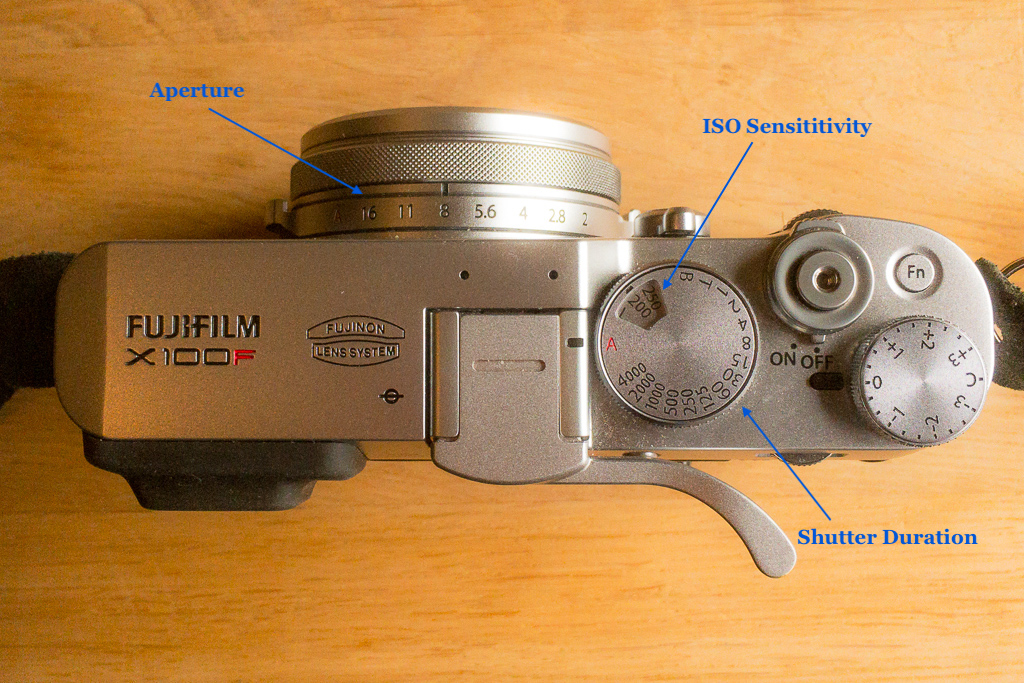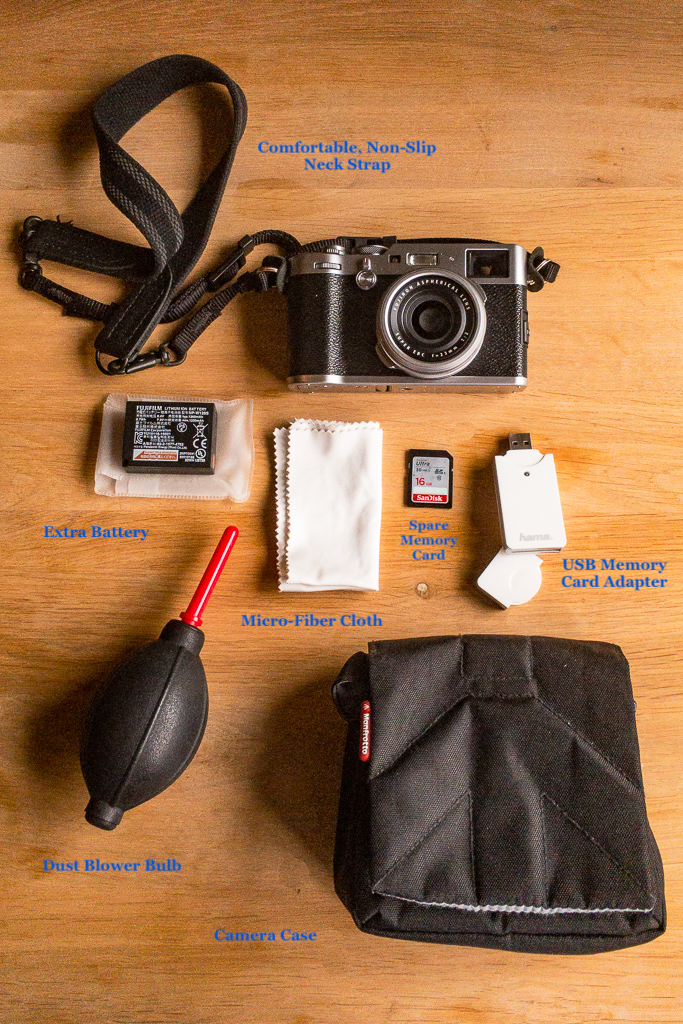New Photography Student Kit
writer: russell j.t. dyer; posted: jul 2009; revised: apr 2018
Equipment Mentioned
If you’ve been taking photographs with one of the low-end compact cameras and want to get a better quality camera with features that will allow you to take better pictures and to learn more about photography, I have some recommendations for you. In fact, I’ve come up with this example of a good starter kit. For this photography student kit, I’m assuming that you’re willing to spend the money for a higher end compact camera, but you’re not yet ready to move into a DSLR camera (larger cameras with interchangeable lenses).
FujiFilm X100F — Primary Controls
On this camera you can adjust manually the shutter speed, ISO sensitivity, and the aperture. Click on image to enlarge and to see labels indicate where these controls are located.
Choosing a Good Camera
When looking for a new camera that will take good photographs and, more importantly, will allow you to learn about photography I suggest that you don’t look for one that has the lowest price (or the highest price), the most megapixels, the greatest digital zoom, the smallest size or the slickest looking model. Instead, I would recommend that you purchase a digital compact camera that has the ability to adjust easily and manually the exposure settings: aperture, shutter speed, and ISO sensitivity. You also need to be able to easily adjust white balance, and focusing area and points. The advantage of having and learning how to use a manually adjustable compact camera is that it will prepare you for when you’re ready to move up to more professional cameras.
In the first photo here is the top of a compact camera, my FujiFilm X100F. It’s a well made camera that takes great photos and has a retro look. It’s a little expensive, though. For have the price you can get a Sony RX100 M3. It’s about half the over size and has an excellent lens and other good features. Whichever camera you buy, just be sure that it has manual controls for exposure settings.
Both of these cameras have all of the automatic presets, but I recommend using manual mode from the beginning — or at least one of the other camera modes that aren’t fully automatic. They both have a high-quality live view screens on the back that shows you the results of adjustments to the different exposures. For instance, if you change the aperture setting (that’s like the pupil of the camera’s eye) to a wider setting, the view screen gets brighter as will the final photo; and if you set it the other way, it gets darker. Being able to see the results of adjustments before you even take the shot like that is helpful in learning what the settings will do.
If you don’t want to worry about going manual mode at this point, the P6000 and the G10 have more than the standard few automatic settings. Some have choices such as Portrait, Landscape, Night Scene, Sports, Foliage, Snow, Beach, Sunset, Fireworks, Aquarium, Underwater, Indoor, Kids & Pets, Night Snapshot, Color Accent, and Color Swap. And they also have a video mode. A camera that takes great pictures in automated mode and lets you easily tweak it later means that it could possibly be the last compact camera you’ll buy. Plus, it will help you to move to better types of cameras when you’re ready.
. rst-class:: sub-heading .. rubric:: Basic Accessories
You will need a few accessories to go with your new camera, as well as to be prepared when taking photographs. These items are important to being a good photographer.
The camera should be protected. You might get a tight fitting camera case or half-case, preferably one made by the manufacturer specifically for your camera. It will minimize scratches and damage from normal use. For when the camera is not being used, you can a snug bag that only adds cushioning around the camera for when you put in a general purpose bag. Or you can get a small camera bag, for carrying the accessories listed below and other items. Whatever you buy, don’t buy a bag that has the name of a camera manufacturer on it. It’s a good security precaution for when you’re not using the camera not to advertise that your bag contains a camera.
New Photography Student Kit
A Good Camera & Basic Accessories
for camera: extra battery, non-slip strap, case;
for lens: bulb, microfiber cloth;
for storage: spare memory card, card reader.
Lenses will get dust and smudges. You will need to clean it, occasionally. Be careful and use the right tools: First try to clean any dust on the lens with a air bulb. If that doesn’t work, use a microfiber cloth. Don’t use any cleaning fluids or water. Not only might that put a film on the lens, on cameras with retractable lenses, the liquids might get inside the camera. If that happens, the camera may be ruined or at least need to be brought in for professional repair.
You may not think you need it, but definitely get a spare battery. If the camera didn’t include an external battery charger, get one of those, too. You should also buy at least two memory cards with a capacity of at least eight gigabytes each. Rather than plug the camera directly into your computer or using a wifi connection, get a memory card reader. They’re much faster at transferring files. Not having a spare battery and a spare memory card can cause an outing to be cut short and photo opportunities to be lost. Being able to transfer files quickly and being able to recharge a battery, both without connecting them to the camera means that you can continue shooting photos.
The last accessory that I’d recommend for a new photography student is a good book about your camera. Some people may think it to be a waste of money when you can just use the booklet that came with the camera. However, I’ve found that most beginners know very little of the capabilities of their cameras. A good book specifically about your camera can help you explore it further than the owner’s manual. They usually include screenshots of the camera’s menus, photos of the camera indicating which buttons to press, and example photographs to show you the results of different settings. Such a book can help you get the most out of your camera. This site has a section listing some recommended <a href=’/books/equip.list’>camera specific books</a>. Additionally, you might check our listing of books for recommendations on photography in general. Just be careful: you can spend a great deal on photography books that look good, but turn out to be disappointing once you start reading them.
Summary
As you can see from the photograph of my compact camera and related equipment, I’m not recommending many items to get started learning about photography. What I am recommending is that you buy smartly: get an excellent compact camera that’s made for would-be photographers; get what you need to be ready to take lots of pictures (e.g., high capacity memory cards and spare batteries); be sure to have what you need to keep your camera clean and protect if from damage and minimize attracting the attention of bag snatchers. And finally, get expanded information on your specific camera, as well as a good starter book on photography.

